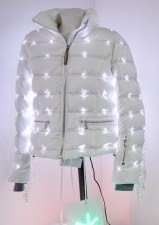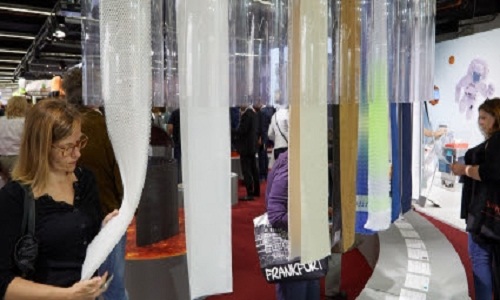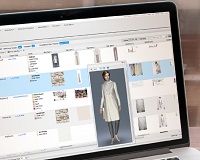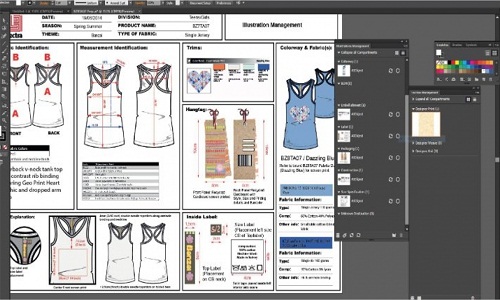FW
Sensoria Fitness is a world leader in artificial intelligence and smart garment technology. It’s known for creating an award-winning product line of health and fitness technology that seamlessly infuses into the fabrics that people are already wearing, such as T-shirts, sports bras and footwear. This innovation allows users to comfortably and accurately measure important fitness metrics in a more familiar way.
An example is Sensoria’s recent partnership with Vivo Barefoot, the leading global producer of barefoot shoes, to integrate its technology into a new pressure sensing running shoe. This new smart shoe helps users detect forces, such as impact score, foot landing and contact time metrics with extreme precision through Sensoria Core technology.
Sensoria Core is integrated into Sensoria’s in-house product line, including its new Sensoria Sock 2.0 that can detect and improve running technique.
These upgraded, ultra-light socks detect crucial core metrics, including cadence, foot landing and impact forces exerted by runners.
The complete Sensoria running system includes a smart T-shirt or sports bra, paired with its smart socks. Together, these devices connect to Sensoria’s new app, Sensoria Run 2.0, which provides real-time feedback through its artificial intelligence coach, Mara, based on a variety of health and fitness metrics.
In 2016, four zones—China, Mediterranean, SAARC and ASEAN—accounted for over 86 per cent of total extra-EU textile and clothing imports.EU-28 imports originating from these groupings primarily related to clothing goods.
The leading position of China as the main supplier of textiles and apparel to the EU has continued to be eroded in 2016 by the increasingly vigorous entry of other production zones. Undeniably, the main beneficiary of this was the SAARC zone, which has grown slowly but steadily since 2010.
In terms of products, China prevailed as the main supplier of woven garments to EU last year. However, China’s share continued to decline to the benefit of South Asian and Mediterranean countries. Concerning imports of knitted garments, China was overtaken by the SAARC zone.
Compared to last year, EU exports’ shares remained stable for the four main defined groupings NAFTA, EFTA, the Mediterranean countries and the group of autonomous countries. These four groups accounted for 58 per cent of extra-EU textile and clothing exports in 2016.
Woven fabrics were the major textiles exported by the EU. The NAFTA zone and the Mediterranean countries were the biggest purchasers of textile goods, while EFTA and NAFTA areas made up the two main buyers of clothing articles.
The East African Community (EAC) partners will adopt a three-year strategy (2017-2019) for the phase-out of importation of used clothes and shoes, through increased levy on these products, compliance with EAC Standards licensing of importers, and categorisation of products per bale of imports. EAC partner agreed to grant garments and textiles manufacturers a three-year waiver of duties and value added tax (VAT) on inputs, fabrics and accessories not available in the region to boost local production and reduce the cost of production. This is one of the strategies to promote textiles and leather industries while slowing down the importation of used clothes, shoes and other leather products from outside the region.
A policy on the recommendations on the modalities for promotion of textile and leather industries states that “The EAC shall grant all EPZ companies an increase of domestic quota supply from the current 20 per cent for a period of three years.
All partner states producing cotton lint to set a target of at least 30 per cent local value addition to domestic cotton lint. The threshold should be increased to 50 per cent within five years.” The EAC has set a four-band tariff structure for cotton, textiles and apparels to promote cotton yarn and fabric production.
The recommendations follow a directive by the EAC Heads of State last year for a study to be conducted on the modalities for the promotion of textiles and leather industries in the region as well as mechanisms for stopping the importation of used clothes, shoes and other leather products from outside the region. To implement the two directives, the Secretariat conducted two separate studies on cotton, textile and apparels value chains; and on leather and footwear value chain.
The study notes that EAC region has the potential to become a major player in the regional production and trade in cotton, textiles and apparels products. Further, the study reveals, the growth of used clothes imports hampers the development potential in the sector.
"Techtextil that held in Germany, May 9 to 12, 2017,recorded number of over 33,670 visitors from 104 countries attended. A new record was also set on the exhibitor side with 1,477 companies from 55 countries taking part. Around 20,800 Techtextil visitors came from outside Germany. The five leading visitor nations at Techtextil after Germany were Italy, France, Turkey, United Kingdom and Belgium."

Techtextil that held in Germany, May 9 to 12, 2017,recorded number of over 33,670 visitors from 104 countries attended. A new record was also set on the exhibitor side with 1,477 companies from 55 countries taking part. Around 20,800 Techtextil visitors came from outside Germany. The five leading visitor nations at Techtextil after Germany were Italy, France, Turkey, United Kingdom and Belgium.
With 423 exhibitors from Germany, and 1,054 from abroad, the level of internationality on the exhibitor side reached 71 per cent, with Lebanon, Mexico and Vietnam being represented for the first time.
Fourteen countries were represented by national pavilions – Belgium, China, France, the United Kingdom, Italy, Canada, Croatia, Portugal, South Korea, Switzerland, Taiwan, the Czech Republic, Turkey and the USA. There was a significant increase in the number of European exhibitors, especially from Spain, Poland, Italy, the Netherlands and Turkey, as well as from China and India.

As always, Techtextil presented the complete spectrum of technical textiles and nonwovens for all areas of application, making it one of the most relevant user fairs for textile innovations. The spectrum of visitors was extremely broad and varied: the fair not only welcomed representatives of protective clothing companies, but also visitors from the automobile sector and the technical applications segment.
The largest exhibitor groups comprised companies with products for applications in the industry, the automobile and aerospace industries, architecture and construction and occupational safety. The highest rates of growth were recorded by the sport, mobility and apparel segments.
From textile-reinforced concrete, via woven fabrics for lightweight constructions, to functionalised textiles: at Techtextil, architects, property developers, engineers and planners were confronted by a wide range of fiber-based materials shown by around 560 exhibitors.
Around 420 exhibitors presented textile solutions for the field of medical technology, from anti-bacterial wound dressings, via fiber-based implants, to sensor textiles for monitoring vital functions.
A total of around 670 exhibitors showed products for cars and trucks, as well as emergency and security vehicles, and aerospace applications.
Altogether, around 880 Techtextil exhibitors offered new materials, coatings, supplementary functions and machines and thus gave designers, garment manufacturers and developers a broad thematic choice and the opportunity for an interdisciplinary exchange of ideas and opinions in the fields of fashion, work wear, protective clothing, sportswear and leisure wear. Particular attention was paid to the subjects of smart textiles and sustainability.
Techtextil exhibitors presented materials for use in space travel. The materials to be seen included functional apparel textiles that not only regulate the wearer’s body temperature but also have anti-bacterial and anti-static qualities, as well as flame-resistant textiles, carbon-fiber components for booster rockets, textile transport bags and belts, and sensory yarns that measure and report loads acting on the textile material.
Wearing virtual reality glasses, visitors could also embark on a journey through space to Mars. During the video flight, viewers were shown examples of applications for technical textiles in space travel, e.g., spacer fabrics for plant growing, functional textiles for astronaut apparel, nature-oriented lightweight structures for architecture in space and textile manufacturing technologies for space-travel antennas.

Lectra, the world leader in integrated technology solutions dedicated to industries using soft materials—fabrics, leather, technical textiles and composite materials, recently launched Lectra Fashion PLM 4.0. The compatible product lifecycle management solution is smart, connected, configurable and user-friendly. It is the first-ever product lifecycle management (PLM) solution designed to help fashion and apparel companies navigate the fourth industrial revolution and thrive in the digital era of fashion.
With digitalisation transforming the way consumers shop, today’s fashion companies are playing a never-ending game of catch-up, as they compete for the attention of a generation of connected, fickle-minded millennials who want it all: personalisation, sustainability, quality and speed, accessible at all times, across multiple channels, and at the lowest price.

“As our customers take their first steps toward the world of Industry 4.0, we want to be right there beside them to help them succeed. Just like today’s fashion companies, we are evolving to make our offer more customer-centric than ever before. We are extremely proud of this powerful new PLM platform, and are convinced that it will help our customers flourish in this digital age of fashion,” says Céline Choussy Bedouet, Chief Marketing and Communications Officer, Lectra.
Compatible with Industry 4.0
Industry 4.0 is not only revolutionising how manufacturers operate but also how brands and retailers need to function, if they want to be fast and agile enough to meet the needs of this demanding new consumer. Lectra Fashion PLM 4.0 has undergone a drastic reboot to give fashion and apparel companies the speed and agility they need to tackle the challenges of Industry 4.0 head on. Lectra Fashion PLM 4.0, with the widest functional scope on the market, acts as an intelligent nerve centre to the digital supply chain, from planning through design to production. This ensures a consistent flow of error-free data between processes, technologies and people. The system connects CAD, industry-standard software such as Adobe Illustrator, company IT systems (such as ERP) and external suppliers, so that actors across the supply chain can work on, save and share information on the platform, ensuring data integrity.
The solution draws on best practices, fashion-business intelligence and real-world scenarios to automate administrative and repetitive tasks, with templates, standard libraries and shortcuts that allows more time for value-added activities. The final result is a fast, connected digital supply chain that helps fashion companies jump on trends quickly and deliver products that fulfill their customers’ expectations.
Workrite Uniform launches a new Dickies FR denim jean line using Mount Vernon FR’s flame resistant (FR) fabric that not only gives protection, but also gives comfort to the workers. The mid-weight denim collection features a 13-oz. FR fabric from Mount Vernon FR called Mustang Flex, combining both protection and comfort. Mustang Flex is part of Mount Vernon FR’s extensive FR denim fabric collection, Phoenix FR.
Mustang Flex denim adds mobility without reduction in FR protection, so workers experience increased comfort and range of motion when wearing the Dickies FR jeans. Mount Vernon FR’s Mustang Flex is engineered for increased comfort and movement, incorporating an elastomeric fiber that allows the fabric to elongate sideways and diagonally. This eliminates any sagging or bagging in the jeans, and makes reaching and bending easier for workers.
The Dickies FR jeans are available in two washes, with a relaxed, contemporary fit. The jeans meet the performance requirements of ASTM F1506, comply with NFPA 70E and are UL certified to NFPA 2112.
SEAMS, recently announced that Will Duncan and Associates (WDA) will assume daily management and operations of the not-for-profit organization. This board level selection of Will Duncan, founder and CEO of WDA, ensures a "Made in America" vision and growth agenda to better support and empower the textile/apparel manufacturers and their suppliers.
Will Duncan, has more than 30 years' experience in management development, process improvement, team-based manufacturing, plant engineering and lean manufacturing he is a well-known industry leader and a recognized speaker and fashion industry consultant.
Jeremy Wootten, president of SEAMS stated that SEAMS gets its new incredible investment for future. The appointment of Will Duncan to manage this organization and operations strengthens the position as the leading association, voice and authority of the U.S.
On this Will Duncan stated that he would support this resurging industry through progressive and timely educational programs, dissemination of information on government regulations and legislation impacting the industry, and adding increased value to our members. The company together would facilitate benefit and service offerings that will help members to control costs and achieve business improvements in future.
Wootten further added that SEAMS regularly endeavors to develop solutions for present major industry like contract and brand manufacturers, suppliers of related products and services issues companies. He wishes to support the company members to be prepared to challenge the new initiatives.
This year has started off on a positive note for Italian textile machinery manufacturers. For the first quarter, orders have increased both in Italy and abroad. Orders for the start of 2017 confirm a positive trend in major foreign markets.
The orders index for textile machinery for the period from January to March grew by 24 per cent, compared to the same period in 2016. This growth was mostly from markets abroad. In Italy, the increase compared to the period from January to March 2016 was 16 per cent.
The index data for the first three months of the year confirm the positive signs seen by businesses in various foreign markets. A renewed climate of enhanced trust is currently perceived in the textile sector, triggered by the government’s commitment to enact a range of significant incentives for the country’s manufacturing system.
Italian textile machinery manufacturers comprise around 300 manufacturers, employing close to 12,000 people and producing machinery for an overall value of about euro 2.6 billion, with exports amounting to 86 per cent of total sales.
Italy is the world’s second largest producer of machinery for the textiles industry. In the production of machinery for tanning, and for the footwear and leather goods industry, Italy accounts for over 50 per cent of world production.
Non-Woven Tech Asia 2017, The 4th International Exhibition & Conference of Nonwoven Industry starting tomorrow (June 08-10, 2017) is organized by Radeecal Communications at Bombay Exhibition Centre, Mumbai, INDIA.
Being the only event in India, Non Woven Tech Asia 2017 focuses exclusively on nonwovens, it has its participation from industry’s leading players like Sonali Polymers, Feather feel Nonwoven Prosper Choice Import Export, Flexography India Press, Vidhi Enterprise, Atlas Chemical Littleberg Offset and many more.
Non Woven Tech Asia 2017 is one of the endeavors of Radeecal Communications, with the potential goal of being the annual pilgrimage for the stake holders of the nonwoven industry. Nonwoven fabrics are one of the most recognized and extraordinary types of fabric that are accessible and commonly used by consumers worldwide. They are bonded together by entangling fiber or filaments mechanically, thermally or chemically.
Non Woven Tech Asia 2017 exhibition is a perfect platform to showcase the products and services of your company and can create the awareness of nonwovens in contemporary life. The exhibitors can expect visitor participation from Andhra Pradesh, Delhi, Maharashtra, Gujarat, Rajasthan, Telengana, Kerala, etc and from international countries also such as Belgium, China, Italy, Japan, etc. Around 8000 visitors during this event from the: medical and health care, hotel industry, yygiene and sanitary products manufactures, packaging industry, schools, luggage products, Textile and apparels, retailers and corporates, traders and distributors, public offices etc segments are to be expected at the exhibition.
Radeecal Communications focuses in conceptualizing, planning, organizing/managing Industry Specific Events in tandem with various Associations and Industry leaders. It objective is to benefit the Industry as a whole.
Bangladesh’s exports rose nearly 1.4 per cent in May from a year earlier, but still 8.5 per cent below target.
For July to May, the first eleven months of the country’s 2016-17 financial year, exports rose 3.7 per cent from a year earlier, 4.7 per cent below the target. For the full year ending on June 30, the export target is 37 billion dollars.
In July to May shipments of readymade garments, comprising knitwear and woven items, were up 2.2 per cent on year. Exports in the financial year that ended in June 2016 were up 9.7 per cent from the previous year, on the back of stronger garment sales.
Bangladesh’s resilience boils down to a combination of the world’s lowest wages after Myanmar and Sri Lanka, the right skills and the fact that China has become less competitive in recent years.
Bangladesh has been aggressively pushing garment exports and has made a slew of policy changes to facilitate these. The country is the world’s second largest exporter of clothing.
Garment exports contribute 80 per cent to Bangladesh’s total export earnings. Bangladesh intends to double its apparel exports to 50 billion dollars by 2021. The US is the largest importer of garments from Bangladesh.












